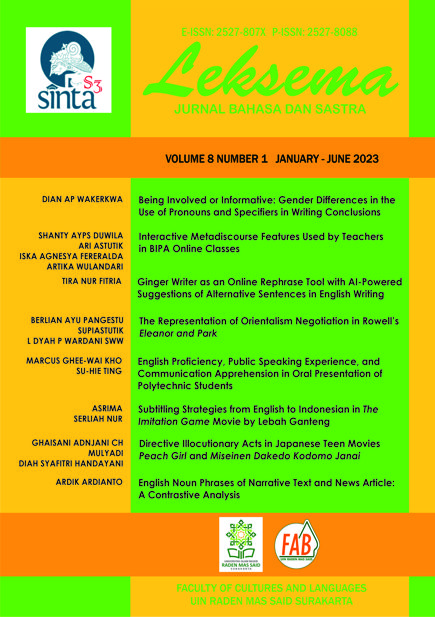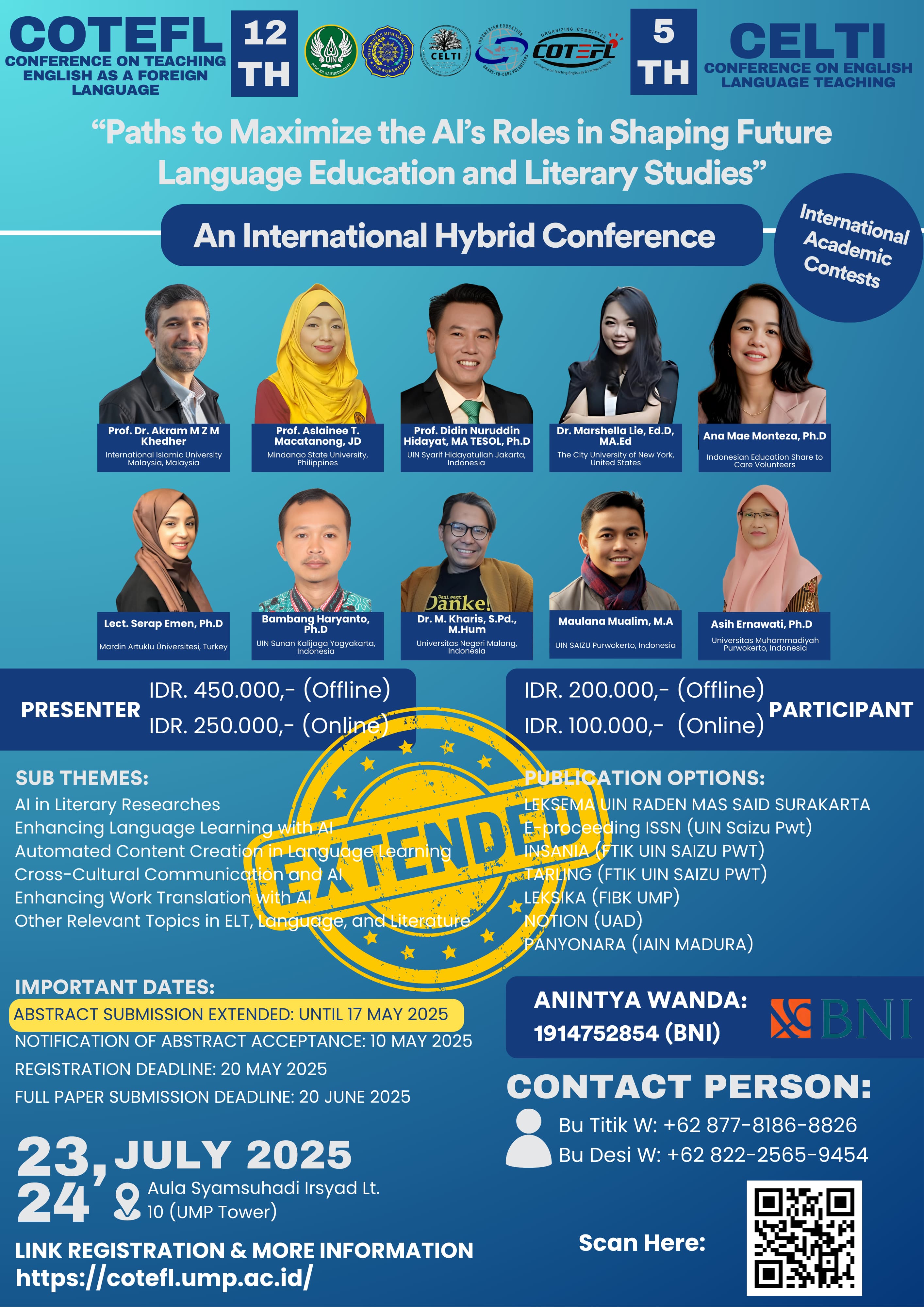INTERACTIVE METADISCOURSE FEATURES USED BY TEACHERS IN BIPA ONLINE CLASSES
DOI:
https://doi.org/10.22515/ljbs.v8i1.5819Keywords:
BIPA, interactive, metadiscourse, online learningAbstract
Language features used by BIPA teachers become one of essential parts during online teaching process. This study incorporated interactive metadiscourse (IMD) proposed by Hyland (2005). It was aimed at describing the functions of the categories and understanding the ways teachers employing IMD markers in BIPA digital classes. The data sources were 4 online BIPA learning videos. Aside from employing a qualitative-descriptive method, this study also used documentation technique and content analysis for collecting and analyzing the data through the process of transcribing the video, coding the data, inputting the data in AntCont 3.4.3, selecting the target words, calculating the occurrences and average, interpreting the data, and drawing conclusion. The results of this study revealed that BIPA teachers incorporated all five categories of IMD markers. The most common IMD markers used are: ok, nah, jadi, lihat, coba, dan karena, kalau,and misalnya. The discourse markers mostly assisted the BIPA teachers to direct students, to point on the slides, to shift from one topic to another, and to express agreements. The findings of this research are expected to give benefits theoretically for scholars and practically for BIPA teachers in conducting online learning.
Downloads
References
Ädel, Annelie. 2006. Metadiscourse in L1 and L2 English: Studies in Corpus Linguistics 24. Amsterdam: John Benjamins Publishing Company.
Ädel, Annelie and Anna Mauranen,. 2010. “Metadiscourse: Diverse and Divided Perspectives”. Nordic Journal of English Studies 9 (2): 1-11. DOI: https://doi.org/10.35360/njes.215.
Arfianti, Ajeng Dini and Utami Widiati. 2021. “Exploring The Use of Translation as a Strategy to Learn English”. Jurnal Pendidikan: Teori, Penelitian, dan Pengembangan 5 (10): 1391-1396. https://doi.org/10.17977/jptpp.v5i10.14099.
Bengtsson, Mariette. 2016. “How to Plan and Perform a Qualitative Study Using Content Analysis”. NursingPlus Open 2: 8-14. DOI: https://doi.org/10.1016/j.npls.2016.01.001.
Correia, Rui, Maskine Eskenazi, and Nuno Mamede. 2015. “Lexical Level Distribution of Metadiscourse in Spoken Language”. ACL Anthology: 70-75. DOI: https://doi.org/10.18653/v1/w15-2708.
Crismore, Avon. 1983. “Metadiscourse: What It Is and How It Is Used in School and Non-School Social Science Texts”. Technical Report: 273.
Crismore, Avon and R. Farnsworth. 1990. “Metadiscourse in Popular and Professional Science Discourse”. The Writing Scholar: Studies in the Language and Conventions of Academic Discourse: 45-68. Newbury Park: Sage.
Defina. 2021. “Penilaian Mahasiswa BIPA terhadap Pembelajaran Tatap Muka dan Online”. Jurnal Bahasa Indonesia bagi Penutur Asing (JBIPA) 3 (1): 12-23. DOI: https://doi.org/10.26499/jbipa.v3i1.3482.
Farahani, Mehrdad Vasheghani. 2020. “Metadiscourse in Academic Written and Spoken English: A Comparative Corpus-Based Inquiry”. Research in Language 18 (3): 319-341. https://doi.org/10.18778/1731-7533.18.3.05.
Farikah, Imam Baihaqi, and Retma Sari (eds). 2017. Pengajaran Bahasa Indonesia Bagi Penutur Asing dalam Kerangka Sastra dan Budaya. Yogyakarta: Graha Cendekia.
Handoko, Muawal Panji, Royan Nur Fahmi, Ferry Yun Kurniawan, Hardina Artating, and Meili S. Sinaga. 2019. “Potensi Pengembangan Bahasa Indonesia menjadi Bahasa Internasional”. Jurnal Bahasa Indonesia Bagi Penutur Asing (JBIPA), 1 (1): 22-29. https://doi.org/10.26499/jbipa.v1i1.1693.
Hyland, Ken. 1998. “Persuasion and Context: The Pragmatics of Academic Metadiscourse”. Journal of Pragmatics 30 (4), 437-455.
Hyland, Ken and Polly Tse. 2004. “Metadiscourse in Academic Writing: A Reappraisal”. Applied Linguistics 25 (2): 156-177. DOI: https://doi.org/10.1093/applin/25.2.156.
Hyland, Ken. 2016. Metadiscourse. DOI: https://doi.org/10.1002/9781118611463/wbielsi003.
Hyland, Ken. 2017. “Metadiscourse: What Is It and Where Is It Going?”. Journal of Pragmatics 113: 16-29. DOI: https://doi.org/10.1016/j.pragma.2017.03.007.
Kopple, William J. Vande. 2012. “The Importance of Studying Metadiscourse”. Applied Research in English 1(2): 37-44.
Lee, Joseph J. and Nicholas C. Subtirelu. 2015. “Metadiscourse in the Classroom: A Comparative Analysis of EAP Lessons and University Lectures”. English for Specific Purposes 37(1): 52-62. DOI: https://doi.org/10.1016/j.esp.2014.06.005.
Maxwell, Joseph A. 2010. “Using Numbers in Qualitative Research”. Qualitative Inquiry 16 (6), 475-482. DOI: https://doi.org/10.1177/1077800410364740.
Molino, Alessandra. 2018. “‘What I’m Speaking Is Almost English…’: A Corpus-Based Study of Metadiscourse in English-Medium Lectures at an Italian University”. Kuram ve Uygulamada Egitim Bilimleri 18 (4): 935-956. DOI: https://doi.org/10.12738/ estp.2018. 4.0330.
Nassaji, Hossein. 2015. “Qualitative and Descriptive Research: Data Type versus Data Analysis.” Language Teaching Research 19 (2): 129-32. DOI: https://doi.org/10.1177/ 1362168815572747.
Ozdemir, Nesihan Onder, & Bernadette Longo. 2014. Metadiscourse Use in Thesis Abstracts: A Crosscultural Study. Procedia - Social and Behavioral Sciences 141: 59-63. DOI: https://doi.org/10.1016/j.sbspro.2014.05.011.
Zhang, Mang, Weiwei Sun, Huan Peng, Qiong Gan, and Bo Yu. 2017. “A Multidimensional Analysis of Metadiscourse Markers across Spoken Registers”. Journal of Pragmatics 117: 106-118. DOI: https://doi.org/10.1016/j.pragma.2017.06.004.
Scott, Philip. 1998. “Teacher Talk and Meaning Making in Science Classrooms: A Vygotskian Analysis and Review”. Studies in Science Education 32: 45-80.
Syafryadin and Feny Martina. 2021. “Direct Empirical Teaching Indonesian for Foreigners: Teaching Techniques and Hindrances”. Tatar Pasundan : Jurnal Diklat Keagamaan 15 (1): 33-44. DOI: https://doi.org/10.38075/tp.v15i1.176.
Tang, Kok-Sing. 2017. “Analyzing Teachers’ Use of Metadiscourse: The Missing Element in Classroom Discourse Analysis”. Science Education 101(4): 548-583. DOI: https://doi.org/10.1002/sce.21275.
Turiman, Samimi, Normah Abdullah dan Noorzan Mohd Noor. 2018. “Spoken Metadiscourse in Malaysian ESL Job Interviews”. GEMA Online Journal of Language Studies 18 (3): 135-152. DOI: https://doi.org/10.17576/gema-2018-1803-08.
Wei, Jing, Yan Li, Ting Zhou and Zhiwei Gong. 2016. “Studies on Metadiscourse Since the 3rd Millennium”. Journal of Education and Practice 7 (9): 194-204. DOI: http://files.eric.ed.gov/fulltext/EJ1095757.pdf.
Downloads
Published
Issue
Section
License
Copyright (c) 2023 Leksema: Jurnal Bahasa dan Sastra

This work is licensed under a Creative Commons Attribution-NonCommercial-ShareAlike 4.0 International License.
The copyright of the received article shall be assigned to the publisher of the journal. The intended copyright includes the right to publish the article in various forms (including reprints). The journal maintains the publishing rights to published articles.
In line with the license, the authors and users (readers or other researchers) are allowed to share and adapt the material only for non-commercial purposes. In addition, the material must be given appropriate credit, provided with a link to the license, and indicated if changes were made. If authors remix, transform or build upon the material, authors must distribute their contributions under the same license as the original.







